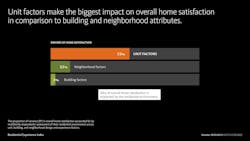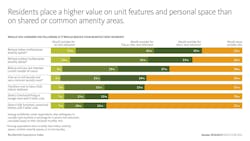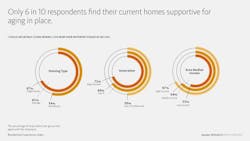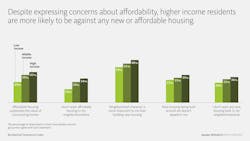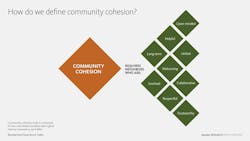5 ways to rethink the future of multifamily development and design
From housing affordability to a dramatic rise in working from home, several factors are influencing how people think about and decide where to live. It’s time residential developers, designers, and other key stakeholders better meet the needs and expectations of residents. The Gensler Research Institute’s recent investigation into the residential experience indicates a need for fresh perspectives on residential design and development, challenging norms, and raising the bar.
Major decisions in many residential projects—from unit size and mix to amenity offerings—too often reinforce the status quo. The focus on standard practices and predictability has resulted in a growing “sameness” of new residential development, and the lack of contextual and innovative solutions only spurs more resistance to new development by local communities. Our survey, which captured the individual experiences of over 13,000 residents in nine diverse markets, attempts to place the needs, preferences, and priorities of actual end-users at the center of our data-driven approach.
Tackling Affordability and Innovation
As we’ve written about before, affordability is a top concern among residents, and it’s something we must thoughtfully balance with design and experience. Freddie Mac’s Chief Economist reports that the “U.S. had a housing supply deficit of 3.8 million units” in late 2020. More supply is undoubtedly needed, but our research also suggests that residents within all income groups are wary of new development, as neighborhood character and community cohesion rank highly among what residents value.
We see opportunities in the complex challenges we face today. So, with an eye to how we create not only more but better housing, Gensler’s Residential Experience Index unpacks the fundamental question: what makes a great living experience? From the resident’s point of view, here are five key findings from our research that demonstrate how we’re considering the future of residential development:
1. Invest more in the personal living space
A lot goes into home satisfaction, including factors related to the unit, building, and neighborhood. But through our analysis, we found that unit-level factors contribute significantly more to this key experiential outcome than attributes outside of the personal living space. We must therefore find a better balance between investing in the unit and building amenity areas, which have long dominated development and design conversations.
Our research also revealed that focusing on design solutions for poor layouts, inadequate storage, and noise issues would build a solid foundation for improving the overall unit experience and better supporting the diverse activities that occur in today’s homes, from working and exercising to cooking and relaxing.
2. Carefully consider the role of building amenities
Amenities may play a key role in getting prospective residents through the door, but our research also identifies these spaces as the ones residents would more likely do away with if necessary. At a time when residents think rents are getting out of control and developers need to cut down on expenses, we believe that targeting the areas that are least valued would be a starting point for reimagining ways to provide residents with differentiated, desirable offerings. In terms of what on-site amenities are most valued, residents across surveyed markets favor fitness centers and on-site parking. A comprehensive amenity strategy should consider not just the available spaces, but the activities and behaviors they could support and how they could change over time in response to residents’ evolving needs and interests among—a balance of space, programming, and service.
Any amenity strategy should also incorporate ways to create a symbiotic and complementary relationship between the building and the surrounding community. In terms of neighborhood offerings, surveyed residents would most prioritize living in walkable proximity to grocery stores, restaurants, and green space.
3. Give residents the choice to stay by supporting aging in place
Not all moves are good moves—sometimes residents want to stay, but can’t due to lack of affordability, social support, or physical accommodation. The CDC describes “aging in place” as “the ability to live in one’s own home and community safely, independently, and comfortably, regardless of age, income, or ability level.”
Our results suggest that many homes fall short of this standard, particularly for residents in multifamily housing. Nearly 30% of older adults surveyed fear that they will not be able to stay in their current home as they continue to age. Parents often move because their location doesn’t support their young children’s needs. Almost half of all respondents with younger children intend to move by 2025. In pursuit of more diverse, inclusive, and longevity-ready communities, new residential development should be able to support the needs of people at all life stages.
4. To confront resistance to multifamily development, redefine strategies to entitlement
Our research suggests that NIMBYism (the “Not In My Backyard” attitude) transcends demographic groups. Owners, long-term residents, and those with higher incomes are the most adamant in resisting new development, but members of other groups also hold anti-housing sentiments. Half of respondents with lower incomes feel that neighborhood character is more important to them than building new housing, and nearly one in three feel that the new housing being built around them doesn’t appeal to them.
The solutions to many of these challenges lie not only in design, but also in finding new ways to better engage communities in new development. While the approval timelines for residential developments across markets keep getting longer, processes today do not necessarily solicit productive, objective, or representative feedback. We have the opportunity to imagine new, streamlined strategies to entitlement that would benefit both developers and residents.
5. As an aspirational goal, focus on fostering community cohesion
The core elements of this concept are trust, respect, and shared purpose among neighbors. Our research finds strong, direct relationships between community cohesion and other key outcomes, such as recommendation, satisfaction, and perceptions of safety. Community cohesion may depend on the relationships between community members, but the built environment can still play a significant role. Of the residents we surveyed who live in multifamily housing, 82% believe it is important to feel a sense of community in their building.
Neighborhoods are comprised of people who are actively invested in their future and success, and wariness to change is often a product of the desire to protect social fabrics and neighborhood character. The creation of more affordable, unsubsidized housing does not need to be at odds with these interests and by focusing the conversation around providing positive, supportive living experiences at the unit, building, and neighborhood levels, we can help create a sustainable path to more housing for all types of residents.
The Residential Experience Index is the result of a multi-year, mixed-methods investigation focused on identifying tactical solutions to help improve the residential experience, particularly for those in multifamily residences, alongside key data expressing how people are currently making decisions about their housing. Our research points to needed shifts in how we approach residential design, development, and delivery in light of evolving resident needs, priorities, and expectations.
About the Author
Gensler
A global design firm with more than 5,000 practitioners networked across five continents, Gensler features insights and opinions of architects and designers on how design innovation makes cities more livable, work smarter, and leisure more engaging. Our contributors write about projects of every scale, from refreshing a retailer’s brand to planning a new urban district, all the while explaining how great design can optimize business performance and human potential. For more thought leadership and blog content, visit our Research & Insight page. Follow us on Facebook, LinkedIn, and Twitter.

